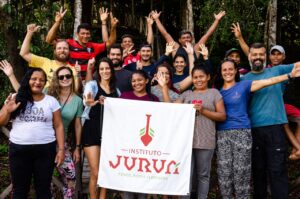The event organized by Instituto Juruá in partnership with the Pé de Pincha Program sought to integrate researchers involved in the conservation of Amazonian turtles.
By Letícia Araújo
The first edition of the Meeting of Research and Conservation of Chelonians of the Juruá River took place on July 19 and 20 at the Amazonian Chelonian Research Center (CEQUA) of the National Institute of Amazonian Research (INPA). The event was organized by Instituto Juruá in partnership with the Pé de Pincha Program and co-financed by the University of East Anglia. The meeting highlighted the defense of the chelonians in the region seeking to integrate researchers specialized in the subject.
“This meeting also aimed to form a more cohesive group of people who are working with chelonians in the Amazon. Several people are working in different organizations and the idea was to bring these people together to discuss, update themselves concerning the research that is being developed, and make institutional partnerships so that these researchers work on collaborative research on the Juruá River”, said Andressa Scabin, Executive Director of Instituto Juruá and speaker at the event.
The meeting was attended by professionals from various institutions: the Brazilian Institute of Environment and Renewable Natural Resources (IBAMA), the Federal University of Amazonas (UFAM), The State University of Amazonas (UEA), the Chico Mendes Institute for Biodiversity Conservation (ICMBio), the National Institute of Amazonian Research (INPA), Wildlife Conservation Society, Environment Secretariat (SEMA), CEQUA, and the environmental association Extractivists, Fishermen and Rural Producers of Itamarati (AAEPRI), a local association of Itamarati that works in the protection of one of the largest turtle hatching beach of Juruá, the plateau of Walterburi.
This area of research felt the memory and death of Richard Vogt in 2021. Vogt worked at INPA and was one of the leading researchers in the field of chelonian conservation in the Amazon. According to Andressa, “the event was important to resume a little of this trajectory of research with chelonians in the Amazon, trying to bring these different groups of researchers together”.
Another initiative discussed at the meeting was the creation of the campaign “Save the Turtles of the Amazon”. The project, set up to begin in 2023, aims to build a financing fund for river beach protectors where turtles hatch, the so-called “plateau”. Typically, this work is done by residents of the communities near the plateaus, but it is still an activity that faces barriers.
“Residents still don’t have adequate compensation for this, and there is an incurred cost that local organizations have to afford. So the idea is to build a global campaign to ensure this program has the condition of maintaining itself in the long run”, explains Andressa.
On the importance of this event, the creator Dr. Carlos Peres, who is the scientific director of Instituto Juruá and professor at the University of East Anglia complements: “The Amazonian fauna of freshwater chelonians is emblematic of the process of historical over-exploitation of natural resources in this region. This event helped to concoct the actions of a group of people central to managing this fauna. I hope that other events of this kind can be promoted by Instituto Juruá.”





